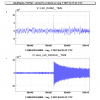Freq tau(s) Q(1e6)
5721.5700 745.10 13.393
7805.2260 419.79 10.294
7993.4930 75.890 1.9058
8908.950 38.000 1.0636
8914.850 108.09 3.0273
9665.981 1079.5 32.781
9670.481 143.85 4.37
10101.06 7.7800 0.24689
12507.78 4.5300 0.17800
12547.40 5.8840 0.23194
the analysis is still in progress.
A first comment is that the Q values measured from ring down are very close to the measurements already presented from the Lorentzian widths.
All the mode shape are identified.
A further evaluation of the NI thermal will follow.



